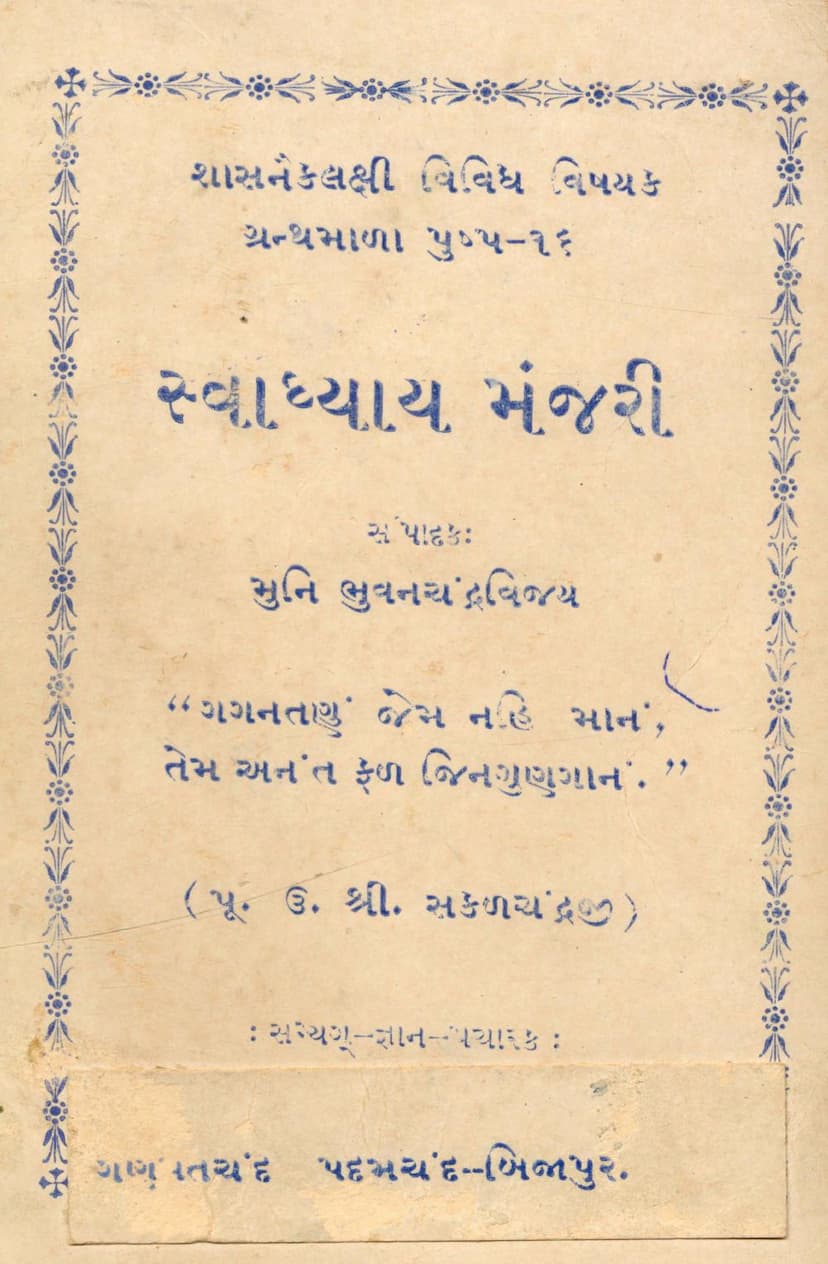Swadhyay Manjari
Added to library: September 2, 2025

Summary
This document is the "Swadhyay Manjari" (स्वाध्याय मञ्जरी), compiled and edited by Muni Bhuvanachandravijay. It is part of the "Shasanai lakshi Vividh Vishayak Granthamala" series (शਾਸનૈકલક્ષી વિવિધ વિષયક ગ્રન્થમાળા), publication number 16.
The book appears to be a collection of devotional hymns and philosophical verses from prominent Jain figures, presented with the intention of deepening spiritual understanding and devotion. The central theme revolves around the glory and teachings of Jainism, particularly emphasizing the virtues of the Tirthankaras and the path to liberation.
Here's a breakdown of the key content and themes found in the provided pages:
Introduction and Purpose:
- The book is dedicated to the "Shasan" (શાસન), meaning the Jain religion or dispensation, implying its aim is to propagate and deepen the understanding of Jain principles.
- The introductory verses highlight the importance of praising the virtues of the Jinas (Jain Tirthankaras), equating it to an "infinite fruit" that is as natural and boundless as the sky.
- The preface emphasizes the profound teachings of Tirthankara Bhagwants, who describe the suffering of the world and establish the path to the indestructible bliss of Moksha (liberation) through Right Faith, Right Knowledge, and Right Conduct.
- It mentions the exploration of Navatattva (nine realities) and Pancha-acharya (five categories of conduct) through the Syaadvada style.
- The text acknowledges the cycle of karma, the illusion created by Moha (delusion), and the soul's eternal attachment to worldly things, highlighting the Tirthankaras' compassion in guiding the soul to freedom.
Content Highlights (Mentioned Authors and Works):
The book appears to be an anthology of important Jain works, as indicated by the authors and their attributed stotras (hymns):
- Shri Siddharshi Gani: Author of the magnum opus "Upamiti Bhava Prapancha" (ઉપમિતિ ભવ પ્રપંચા), a metaphorical epic. The compilation begins with a stotra from this work, possibly addressing the soul's plight in the cycle of existence and a plea to the divine for liberation.
- Mahamahopadhyaya Shri Yashovijayji Maharaj: A highly learned scholar and philosopher of the 17th century. The text features his "Paramatma Panchavishatika" (પરમાત્મ પંચવિંશતિકા), a work focusing on the supreme soul, the path of pure knowledge, the perils of attachment and aversion, and the description of Siddha Sukha (the bliss of the liberated). The text praises his profound spiritual insights.
- Maharaj Shri Kumarpal: A renowned Jain king and patron of Jainism, credited with composing the "Sadharan Jin Stvanam" (સાધારણ જિન સ્તવનમ). This work is described as containing self-reflection, praises of the divine without exaggeration, and a powerful appeal in its concluding verses.
- Mahakavi Dhanpal: A great poet. The compilation includes his "Shri Rishabh Panchashika" (શ્રી ઋષભ પંચાશિકા), a collection of 50 verses. The text expresses immense admiration for Dhanpal's poetic brilliance, stating that words fail to capture its essence and that the poem itself embodies the teachings of the Tirthankaras and the path to liberation.
- Kalikal Sarvagya Shri Hemchandrasurishwarji Maharaj: A paramount Jain acharya, known for his immense scholarship and influence. The text includes his "Shri Vitrag Stotram" (શ્રી વીતરાગ સ્તોત્રમ્), a significant work that describes the divine attributes, the eight auspicious symbols (Ashta Pratiharya), the essence of detachment, the contrast between true and false deities, the philosophy of permanence and impermanence, and the principles of Syaadvada and Anekantavada. The verses also touch upon the importance of obedience to divine commands for achieving liberation.
Themes and Philosophical Concepts:
- Devotion and Praise (Bhakti and Stuti): A central theme is the fervent devotion and praise of the Tirthankaras and Siddhas, recognizing their infinite virtues and their role as saviors.
- The Path to Liberation (Moksha Marga): The text consistently emphasizes the Jain path to liberation through Right Faith, Knowledge, and Conduct. It highlights the cyclical nature of birth and death driven by karma.
- Detachment (Vairagya): The importance of detachment from worldly pleasures and possessions is a recurring motif, as exemplified by the virtuous kings and ascetics mentioned.
- Karma and Liberation: The concept of karma as the binding force and the Tirthankaras' teachings as the means to break free from these bonds are integral to the text.
- Syaadvada and Anekantavada: The philosophical principles of conditional predication and non-one-sidedness are mentioned as integral to the Jain approach to truth.
- The Nature of the Divine: The Tirthankaras are described as pure, omniscient, omnipotent, compassionate beings free from all worldly afflictions and attached to no particular form.
- Spiritual Transformation: The text aims to inspire readers to internalize the pure nature of Dharma, attain the detachment of the liberated, and awaken the resonance of liberation within their souls.
Structure and Presentation:
- The book is presented in Gujarati, with verses from various authors often followed by brief explanations or appreciations in Gujarati.
- The inclusion of Sanskrit verses (like those from "Paramatma Panchavishatika" and "Shri Vitrag Stotram") suggests a scholarly and comprehensive approach to presenting these devotional works.
- The "Shuddhipatra" (શુદ્ધિપત્ર) on page 17 indicates corrections or errata for the publication.
- The concluding pages feature acknowledgments and tributes to various Jain acharyas and patrons.
In essence, "Swadhyay Manjari" serves as a spiritual guide and a collection of revered Jain devotional literature, intended to uplift the reader's soul and deepen their understanding of Jain philosophy and practice. It draws upon the wisdom of prominent Jain saints and scholars to illuminate the path to spiritual liberation.